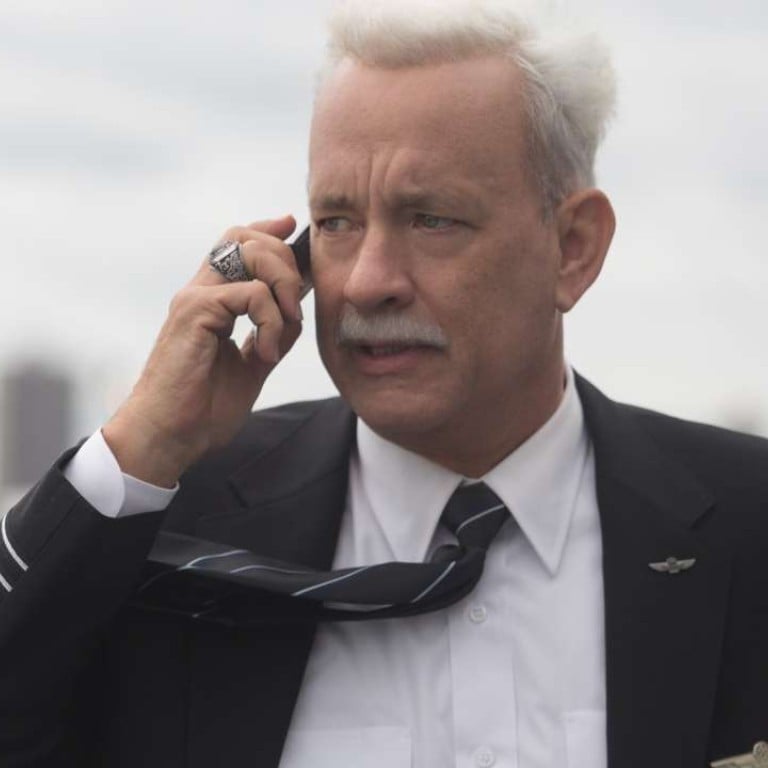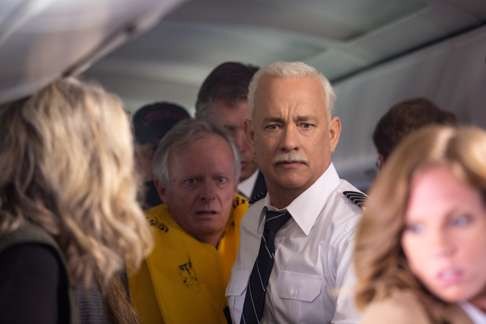
How Tom Hanks and Clint Eastwood found drama in Miracle on the Hudson
The story’s happy ending is well known, but, as director and lead actor explain, their focus is on the months after pilot Chesley Sullenberger’s daring water landing, when he had to justify his actions under intense official questioning
On a cool January afternoon in 2009, people looking out over the Hudson River in New York couldn’t believe their eyes: a US Airways Airbus looked like it was falling out of the sky. Then it descended from the air and landed right in the middle of the water. Within minutes, the 155 traumatised but mostly unhurt passengers and crew were standing on the partially submerged wings, waiting to be taken ashore by emergency rescue crews.
The pilot, Chesley Sullenberger, became a global hero, with the event nicknamed the Miracle on the Hudson.
A flock of birds had flown into both engines of his plane soon after he took off from New York’s LaGuardia Airport for Charlotte in North Carolina – a 90-minute hop he routinely flew. With no power from either engine, he didn’t think he could make it back to an airfield. Dropping into the Hudson was, he thought, his only option.
That split-second decision is at the heart of Sully, an IMAX-shot film directed by Clint Eastwood and starring Tom Hanks as the pilot who became a household name. Because everyone knows how the story ends – no deaths, everyone safe, a miracle of happenstance and skillful execution – Eastwood wasn’t initially sure that it was movie fodder.
“The first thing I was asked when presented with the project was, ‘Where’s the conflict? Where’s the basis of the drama?’” Eastwood says on a recent afternoon in Los Angeles. “But there was a part that the general public never got.”
Interview: How At Cafe 6’s director Neal Wu turned teenage heartbreak into a successful career
In the months after the emergency landing, as Sullenberger was being praised and given all sorts of commendations, and as he was writing what would become a bestselling book, the National Transportation Safety Board (NTSB) launched a complex and intensive investigation. Which meant that Sullenberger, instead of being held up as a model pilot, was forced to defend his actions, and to answer the question: did he, alongside his co-pilot, really have to ditch his plane in a river?

Those tense depositions, which took the better part of a year, caused Sullenberger to reflect on the wisdom of his actions within that span of 208 crucial seconds – and, says Eastwood, that’s where the conflict comes from. “The decision made between those two pilots is the whole picture. It’s the whole motivating thing for the film. There were certain people trying to allude to the fact that he might have done the wrong thing, and he had to sit there and prove that he didn’t.
“Nobody knows what they’re going to do in those circumstances. Even if you follow every protocol, nobody knows how they are going to react when something like that happens under the sea, or in the air, or no matter where you are.”

Hanks, who is no stranger to playing real-life people – Captain Phillips, Walt Disney in Saving Mr Banks, astronaut Jim Lovell in Apollo 13, to name just a few – imbues Sully with the requisite amounts of strength and self-doubt. The two spent a great deal of time together, with Hanks wanting to understand the essence of what drove Sullenberger that day, and also in his life up to that point.
“It’s a very difficult position, having lived through something and then realising that someone is going to be making a movie about it,” says Hanks. “I talked to him on the phone, I went to his house, I spent a lot of time with him. I said to him, ‘Look, I’m going to say things you never said, do things you never did, be in places you never were. And regardless of that, we want to get it right, we want it to be authentic, we want it to be true.’ He completely got that.”
Interview: Hangover director Todd Phillips brings his bromance expertise to arms-dealer drama War Dogs
Still, Eastwood and Hanks – alongside Aaron Eckhart as co-pilot Jeff Skiles and Laura Linney as Sullenberger’s wife – hew as close to the truth as possible.
“He walked me through the script, and there were things he cared about a lot,” says Hanks of his time with the pilot. “That the vernacular was accurate especially. But he was very understanding about the compression that has to go through when you make a movie like this.”

The most important thing for Sullenberger, says Hanks, was that the NTSB was not shown in an unflattering light, even if – to audiences – their investigation of the pilot’s actions seems just short of aggressive.
“One of the areas he was surprisingly adamant about was that he did not want the NTSB to be presented as prosecutors, which they weren’t. They weren’t the bad guys out to nail him. He’s been on those boards himself. He’s investigated accidents. They were just trying to establish exactly what happened,” says Hanks.

As the film shows, every possible cause of the incident, as well as potential instigators for what motivated Sullenberger to land in the water, had to be unearthed in excruciating detail: did he have a fight with his wife? Did he have high blood sugar? Did he drop a pen that got jammed in the rudder controls of the plane? Was there anything out of the ordinary that happened? In the making of the film, Sullenberger had to lay all that out on the table.
“He was thorough,” says Hanks. “He was very open about those pressures. He was looking for a nice, clean flight out of this movie.”
Interview: Young Hong Kong director’s perseverance pays off as his debut feature Weeds on Fire hits cinemas
The film, as envisioned by Eastwood, does not take a linear format, which in this situation would have been just a little too predictable. It jumps back and forth through different points of time. It opens after the fact – Sullenberger is plagued with nightmares about what might have been if things hadn’t gone in his favour, and that always lingers in his mind.
From there, it’s a briskly dramatic feature that plays out vaguely like a thriller; it’s all over, there are no spoilers, everyone knows what the outcome was. But Eastwood imbues the narrative with a taut agitation that does leave viewers on the edge of their seats.

“I wanted to show the actual thing at the very end, exactly as it happened,” says Eastwood. The actual filming of the water landing took place using a real Airbus and a lake: Eastwood confirms that recreating it on the Hudson would have been prohibitively expensive and nearly impossible. The filmmaker and actors also spent time at an aircraft simulation facility in San Francisco that proved eerily real.

“It was crazy impactful,” says Hanks, adding that those critical 208 seconds were practised in minute detail there. “There’s physics involved. You feel the plane moving and gravity pulling you because of what gravity can do on hydraulic jacks, and there was a digital rendering of New York city and the Hudson.”
According to Eastwood, he had in fact asked Sullenberger who he envisioned to play him before Hanks was brought on to play the part. “He said he didn’t know, and that whatever I wanted to do was fine,” says the director. “He’s humble that way. I said to him, ‘What about Tom Hanks?’ He agreed. And Tom visited him, and did everything to get to know him. He’s a real pro, curious enough to go and meet the real deal.”
Interview: For Call of Heroes, Benny Chan summons his inner Akira Kurosawa and Sergio Leone
Hanks is widely regarded as an extremely intelligent and intuitive actor, and it was his instincts that drove him on how to truly inhabit the role of someone who has become, for many, a modern icon. The creative licence he ended up taking, he says, was more a result of having to compress certain key events so as to move the narrative along.
But there were other things as well. “Like the interior monologue that Sully is going through. And I vetted every beat of the screenplay with him. It’s really mostly what you omit as opposed to what you do.”

There were a number of things that were absolutely true, says Hanks, like Sullenberger being recognised wherever he went. “He’s got the shock of white hair, the moustache. And he runs all the time. He’s in so much better shape than my fat ass, it’s almost startling. He wears the same size pants he wore in high school, for crying out loud.
“I’ve done a substantial amount of non-fiction material, and that’s the beat. What we didn’t do, in any way, in the course of the movie was alter his motivations or editorialise on what went on. That’s where non-fiction movies go off the rails. They’re trying to put forward some sort of ex post facto reason for what happened. [But how this story was depicted] is not contrary to the truth and authenticity of the piece,” says Hanks.
Sully opens on September 15
Want more articles like this? Follow SCMP Film on Facebook

